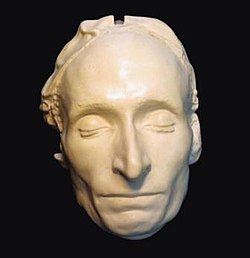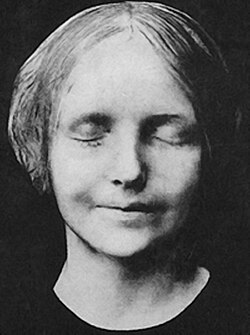Death mask

In the 17th century in some European countries, it was common for death masks to be used as part of the effigy of the deceased, displayed at state funerals. During the 18th and 19th centuries they were also used to keep a record the faces of unknown bodies. This is now done with photographs.
Phrenologists and ethnographers used both death masks and life masks (taken from living people) for scientific and pseudoscientific purposes. A death mask is a wax or plaster cast made of a person’s face. Death masks may be mementos of the dead, or used for creation of portraits. It is sometimes possible to tell if paintings have been copied from death masks, because shape of the face is altered by the weight of the plaster during the making of the mould. In some cultures a death mask may be a clay or other item placed on the face of the dead person before burial rites. The best known of these are the masks used by ancient Egyptians as part of the mummification process, such as Tutankhamon’s burial mask. In the 17th century in some European countries, it was common for death masks to be used as part of the effigy of the deceased, displayed at state funerals. During the 18th and 19th centuries they were also used to keep a record the faces of unknown bodies. This is now done with photographs.
History
Sculptures
Masks of dead people are a tradition in many countries. The most important process of the funeral ceremony in ancient Egypt was the mummification of the body. After prayers and consecration, the body was put into a sarcophagus decorated with gold and gems. A special part of the rite was a sculpted mask, put on the face of the dead person. This mask strengthened the spirit of the mummy and guarded the soul from evil spirits on its way to the afterworld. The best known mask is that of Tutankhamun. Made of gold and gems, the mask shows the highly stylized features of the ancient ruler. Such masks were not, however, made from casts of the features. The mummification process itself kept the features of the dead person.
In 1876 the archaeologist Heinrich Schliemann discovered in Mycenae six graves, which he believed were those of kings and ancient Greek heroes—Agamemnon, Cassandra, Evrimdon and others. To his surprise, the skulls were covered with gold masks. It is now thought by some unlikely that the masks actually belonged to Agamemnon and other heroes of the Homeric epics.
The lifelike character of Roman portrait sculptures has been linked to the earlier Roman use of wax to keep the features of dead family members. The wax masks were then remade in stone.[1]
Casts

In the late Middle Ages, a shift took place from sculpted masks to true death masks, made of wax or plaster. These masks were not buried with the dead. Instead, they were used in funeral ceremonies and were later kept in libraries, museums and universities. Death masks were taken not only of dead royalty and nobility (Henry VIII, Sforza), but also of important people—poets, philosophers, and dramaturges, such as Dante, Filippo Brunelleschi, Torquato Tasso, Blaise Pascal and Voltaire. Like in ancient Rome, death masks were often then used in making marble sculpture portraits, busts or engravings of the deceased.
Oliver Cromwell’s death mask is kept at Warwick Castle. Another famous death mask is that of Napoleon Bonaparte, taken on the island of Saint Helena and displayed at London’s British Museum.
In Russia, the death mask tradition dates back to the times of Peter the Great, whose death mask was made by Carlo Bartolomeo Rastrelli. Also well known are death masks of Alexander I, Nicholas I and Alexander II.
One of the first real Ukrainian death masks was that of the poet Taras Shevchenko, made by Peter Clodt von Jürgensburg in St. Petersburg, Russia.[2]
Science
Death masks were used by scientists from the late 18th century onwards to record differences in human physiognomy. The life mask was also increasingly common at this time, taken from living persons. Anthropologists used such masks to study physiognomic features in famous persons and notorious criminals. Masks were also used to collect data on racial differences.
Forensics
Before the invention of photography, the faces of unknown bodies were sometimes kept by making death masks so that relatives of the dead could recognize them if they were looking for a missing person.
One such mask, known as L'Inconnue de la Seine, recorded the face of a young woman who had drowned in the Seine River at Paris around the late 1880s. A worker at the Paris morgue was so taken by her beauty that he made a plaster cast of her face. She was considered so beautiful that in the following years copies of the mask became a fashionable item in Parisian Bohemian society.[3] The face of Resusci Anne, the world’s first CPR training mannequin, introduced in 1960, was modeled after L'Inconnue de la Seine.[4]
Death Mask Media
The death mask of 18th century sailor Richard Parker
Posthumous portrait bust of Henry VII of England by Pietro Torrigiano, supposedly made using his death mask
Bronze death mask of Napoleon
Related pages
References
- ↑ H.W. Janson with Dora Jane Janson, History of Art: A Survey of the Major Visual Arts from the Dawn of History to the Present Day, Englewood Cliffs, New Jersey, Prentice-Hall, and New York, Harry N. Abrams, 1962, p. 141.
- ↑ Virtual Museum of Death Mask Archived 2018-03-08 at the Wayback Machine URL accessed on December 4, 2006.
- ↑ Elizabeth Bronfen, Over her Dead Body: Death, Femininity and the Aesthetic, MUP, 1992, p. 207.
- ↑ "The Girl from the River Seine". Laerdal. Retrieved 8 October 2012.[dead link]
Other websites
| Wikimedia Commons has media related to Lua error in Module:Commons_link at line 62: attempt to index field 'wikibase' (a nil value).. |
- Laurence Hutton Collection of Life and Death Masks Archived 2006-03-07 at the Wayback Machine
- Before and After Death Archived 2011-06-13 at the Wayback Machine Photographic portraits of people before, and immediately after, they die
- Collection of Death Masks Archived 2009-01-16 at the Wayback Machine History of death masks, Pictures of death masks and historical resources
- Ancient Egyptian Masks by Egy King





